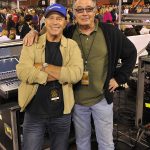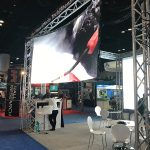Evert once in a while, a story pops up about the value of being educated properly in the technical aspects of the entertainment biz. This education could come from your college, your own school of hard knocks (meaning other folks taking time to school you) or perhaps your high school theater teacher. This education likely took years and molded you into the person you are today.
“Hopefully you have taken the time to pay it back.”
That’s one of the statements that Daric Bassan makes to me this morning at US Cellular ballpark on the south side of Chicago. Daric grew up three miles from this stadium, and he’s proud to be doing the first rock show ever at his beloved White Sox house. He’s been all over the world, but has always lived in Illinois. He’s a crew chief, he’s a shop foreman, a tinkerer and a teacher of how to do things the right way.
A Solid Foundation
By the time Daric was in high school, his parents had moved him out of the city to a suburb called Oak Park. The high school there was known for having a tremendous tech department, which included a 1,200-seat theater. “Everything I need to know about this business, I learned in high school,” Bassan says, proudly. Hard to imagine? Not if your teacher was a guy by the name of R.J. “Mike” Nielsen. A popular teacher who in his day taught such top notch techs as rigger Michael Reed (Chicago’s Reed Rigging), Gareth Conner (Creative Conners Stage Automation), Joe Champelli (director of mechanical design for Entertainment Project Services) and lighting designer Tyler Elich (Orangelite) over the years. (Other famous graduates who attended this high school include Kathy Griffin and Ernest Hemingway.)
Learning Different Disciplines
“The first thing I was taught was ‘You go where you’re told.’ Nielsen somehow saw something in me and assigned me to work as an assistant electrician for my first couple shows. I found I liked it and was ready to move forward. Then I walk into the tech day of the next production and I’m told I’m now a carpenter. I balked at first. Then he patiently explained to me that the more skills you have, the better. The people that get the work in theater are well versed in both lighting and carpentry. I try to explain that to kids these days. It’s beneficial to know what everyone else is doing on a stage besides just your department. Like I always think, ‘How can I help that person over there…help me?’”
Bassan shares another thing he was taught about production before he went off to college. “If you don’t hold up your end, someone else is going to suffer. You have to care about everyone else and how your gig affects theirs.” After Oak Park, he enrolled at Southern Illinois University in Carbondale, IL, a university where Nielsen previously worked. They had a 12,000 seat arena, a theater and another room. Bassan pursued a history major, but he was also a legacy in the theater department because of his old teacher. He immediately became a non-union stagehand at the arena where JAM Productions booked concerts. His first show was with Marshall Tucker, then “I did my first 22-hour work day for Ted Nugent. I left that show and I knew this business was for me.”
Two Jobs, then Touring
In the end, Daric was working at the theater and local crew jobs for 100 hours per week. There was no time for school. ‘I was literally paying the school to be a stagehand. I couldn’t figure out how to get into touring, so I took my theatre drafting experience and applied it to architecture classes.” He ended up back in Chicago. One day, he got a tip to look for ads in the local live music mag (Illinois Entertainer) for companies that offered lighting production. He called two places and got hired on the phone by both, and managed to work for both, doing local shows for a nine-year span. “I kept training guys, then they would leave me for other companies in town,” Bassan says. But he still wanted to give touring a try, stating, “I set out to do something, and needed to see if I could do it.” By 1993, he had gotten acquainted with some guys at Upstaging, which had been sub-renting gear from him on occasion. He approached them for a job and got hired. “From the first minute I walked in the shop, I knew they did quality work — the way you should,” Bassan says. “It was a revelation when I realized I could be a part of this.”
Getting It All Done
LD Nook Schoenfeld, who met Bassan on an Eagles tour in 1994, was impressed with his ability to “silently get a lot of little things done that save you hours in the long run.” A case in point: “We had about 100 Par cans wrapped around the rest of the movers. I hate taking time to focus Pars. But we had a box grid with lots of them for fill lighting. Daric ran the 160 feet of truss while I called focus. He executed the entire Par focus in six minutes. That’s a Par about every five seconds. He never stopped. On top of this, the guy would go up on the truss as soon as load out started — and he undid every cable before the truss hit the deck. His foresight cut 30 minutes off of load-out. Ever since then, he’s been my go-to guy on structures. I come up with some whack ideas that I cannot visualize how to possible erect. I send these half-baked ideas to him. Forty-eight hours later, there’s a plan in motion.”
Teaching Others
In 1997, Bassan took on the job as shop foreman, but by no means did he leave the road. “I found myself in a position where the company grew rapidly and we had to teach a lot of people how to do things our way. Besides young kids coming into the shop, we had to bestow upon all the freelancers that this is how we roll as professionals here. Because of all the hours they work there, I had to train a couple of guys that could cover me as well.” Daric is still called on to hit the road to start up a bunch of tours. Neil Diamond doesn’t start a new leg of a tour without Bassan being involved in the production. He takes Marilyn Lowey’s plot, production manager Mikie Weiss’ input and draws up the working plots. He works with the crew chief to make sure all the gear is top-notch and is there for the initial load in. He leaves the tour once the client is happy.
Still Covering the Bases
“I go wherever I have the most value for my company,” says Daric. “Sometimes I may have to start up a tour for a couple weeks until the usual crew chief is free from another commitment. Some shows I do every year because I like them. I have been involved with a local Triton College circus for years that does great stuff. My daughter Cassie performs in it and I light it. I’m actually only down here at US Cell right now because crew chief Mike Hosp all of a sudden had another commitment and I volunteered to bail him out; as I’ve done for years.”
Bassan notes that people keep challenging him with designs. “Can we do this?” and “Of course we can” are two sentences that explain how his mind works. “I bring a road guy mentality to the shop. It instills how we put things together. I was taught something by Nielsen when I was only a 15-year-old high school student. ‘You don’t design for the stage; you design for the truck.’ That’s always stuck with me.”


